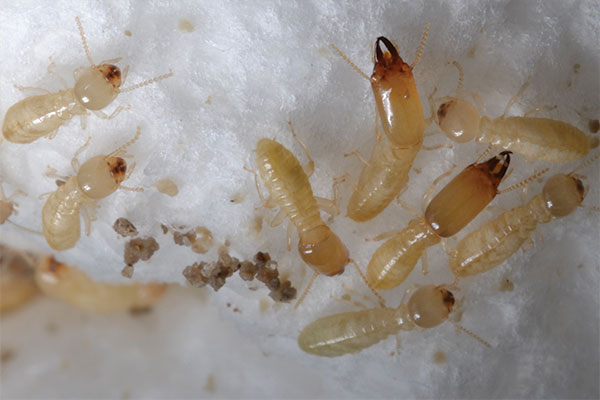(Reticulitermes flavipes)
These pests are criminally cryptic and dastardly damaging.

Photo: NPMA
- Description: Workers are less than 1/8th in. long, soft-bodied, and creamy-to-grayish white. They have round heads and are blind and wingless. Soldiers have a rectangular, yellowish-brown head, black mandibles and are wingless. Alates are less than 1/2 in. long and black, with beaded antennae and two pairs of grayish-transparent, equal-sized wings.
- Life cycle: Gradual metamorphosis, social castes. Eggs placed by primary or supplementary reproductives. Larvae undergo several molts, developing into worker, soldier, supplementary reproductive, or winged reproductive castes. Nymphal termites are non-terminal and can revert to worker caste (pseudergates). Mature colony is 20,000 to 5 million workers. Primary queen adds 5,000 to 10,000 eggs per year. Swarming is diurnal (during the day), February to April. Female and male alates shed wings, pair up and form new colonies (royal cells).
- Habitat: Moist soil or environment. Water conservation is critical to termite survival. They experience rapid water loss upon air exposure. Termites construct shelter tubes to travel over vulnerable areas. These tubes conceal, provide a moist environment, and protect them from antagonists.
- Food: Studies show they prefer slash pine (Pinus elliottii) and loblolly pine (P. taeda). Termites consume wood at a rate of about 2.5 percent of their body weight per day. An average size colony of 60,000 termites can consume about 5 g of wood per day, or a 1-ft. length of a 2×4 in about 118 days.
- Unusual behaviors: Termites are negatively phototropic, which means they move away from light. They also use trophallaxis, which means they reciprocally exchange nutrients via termite colony members (mouth to mouth and mouth to hind gut). The process lets them share essential cellulose-digesting gut protozoa, heightens recognition among colony members, and distributes caste regulatory chemicals.
Leave A Comment